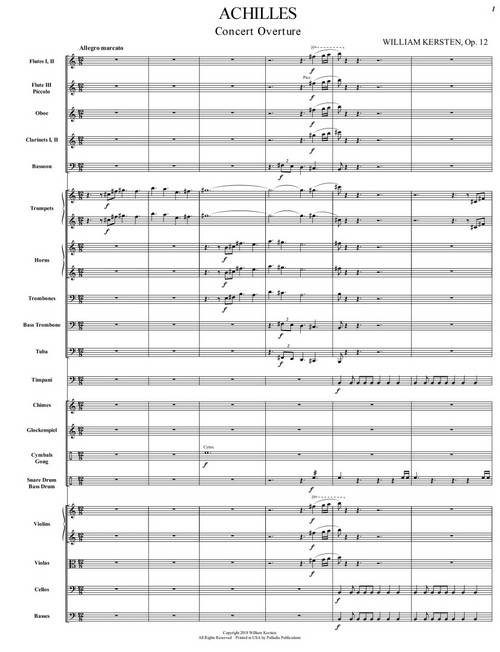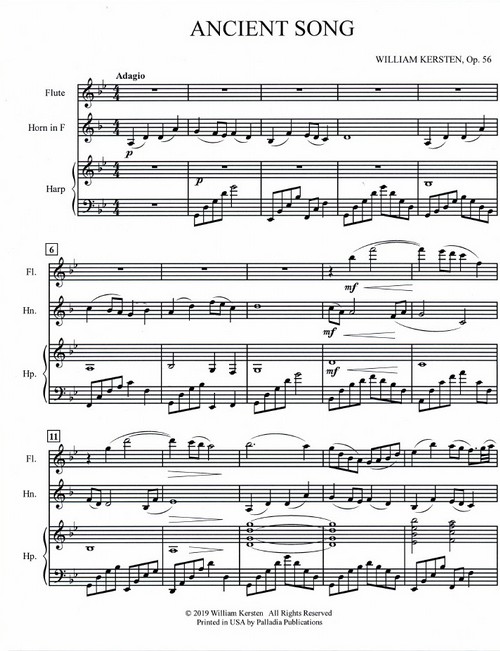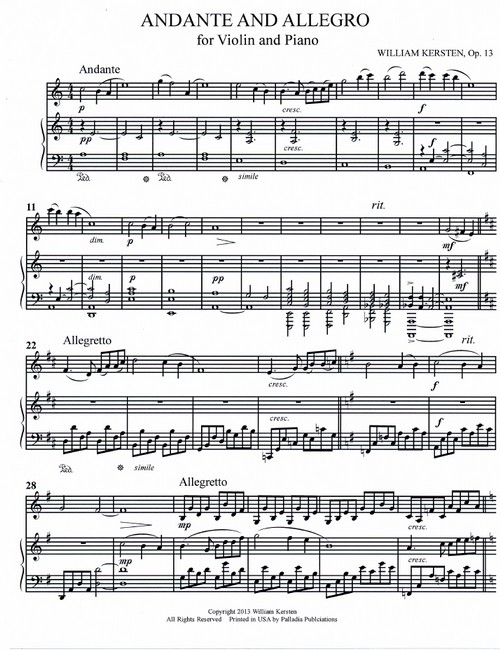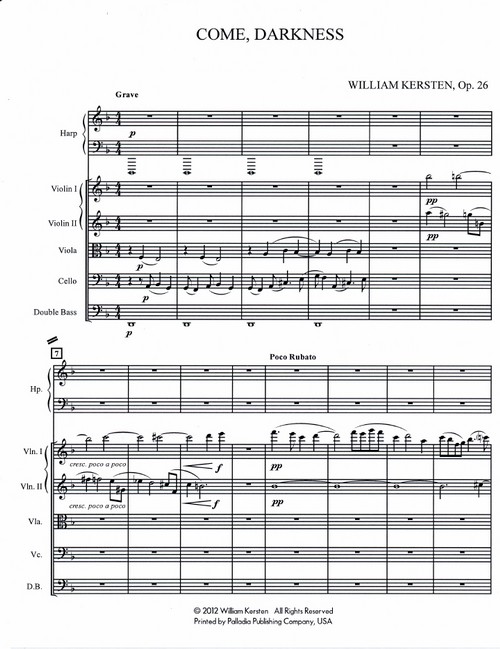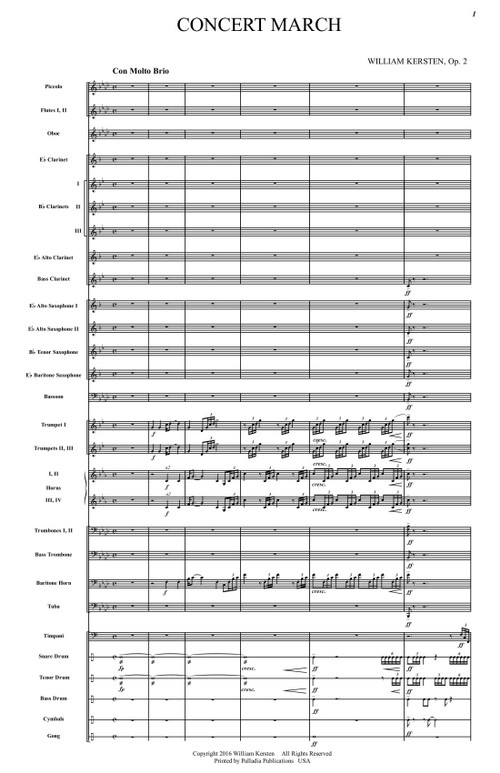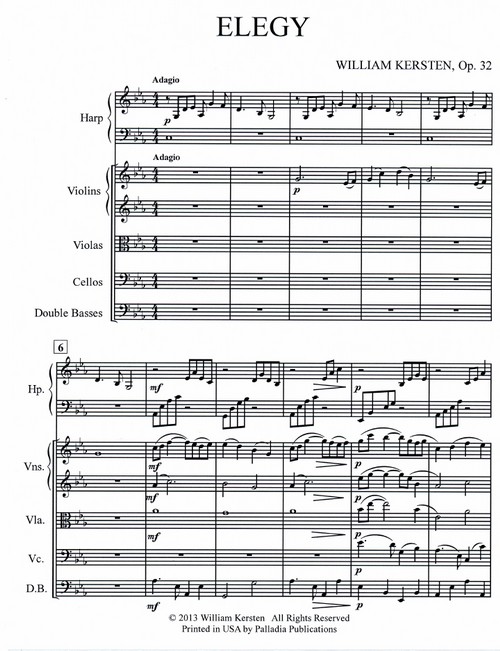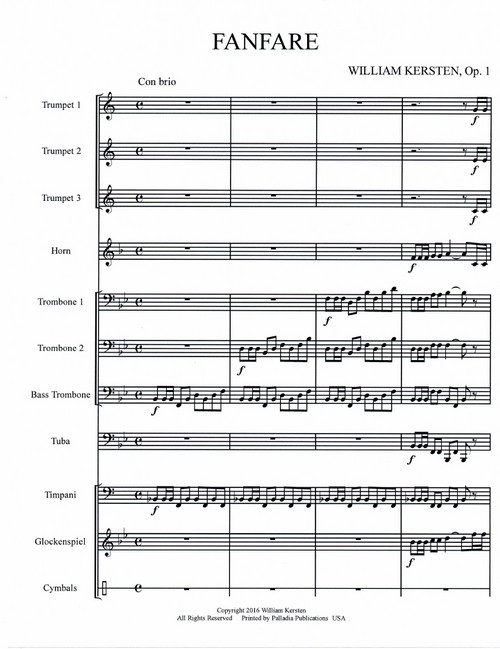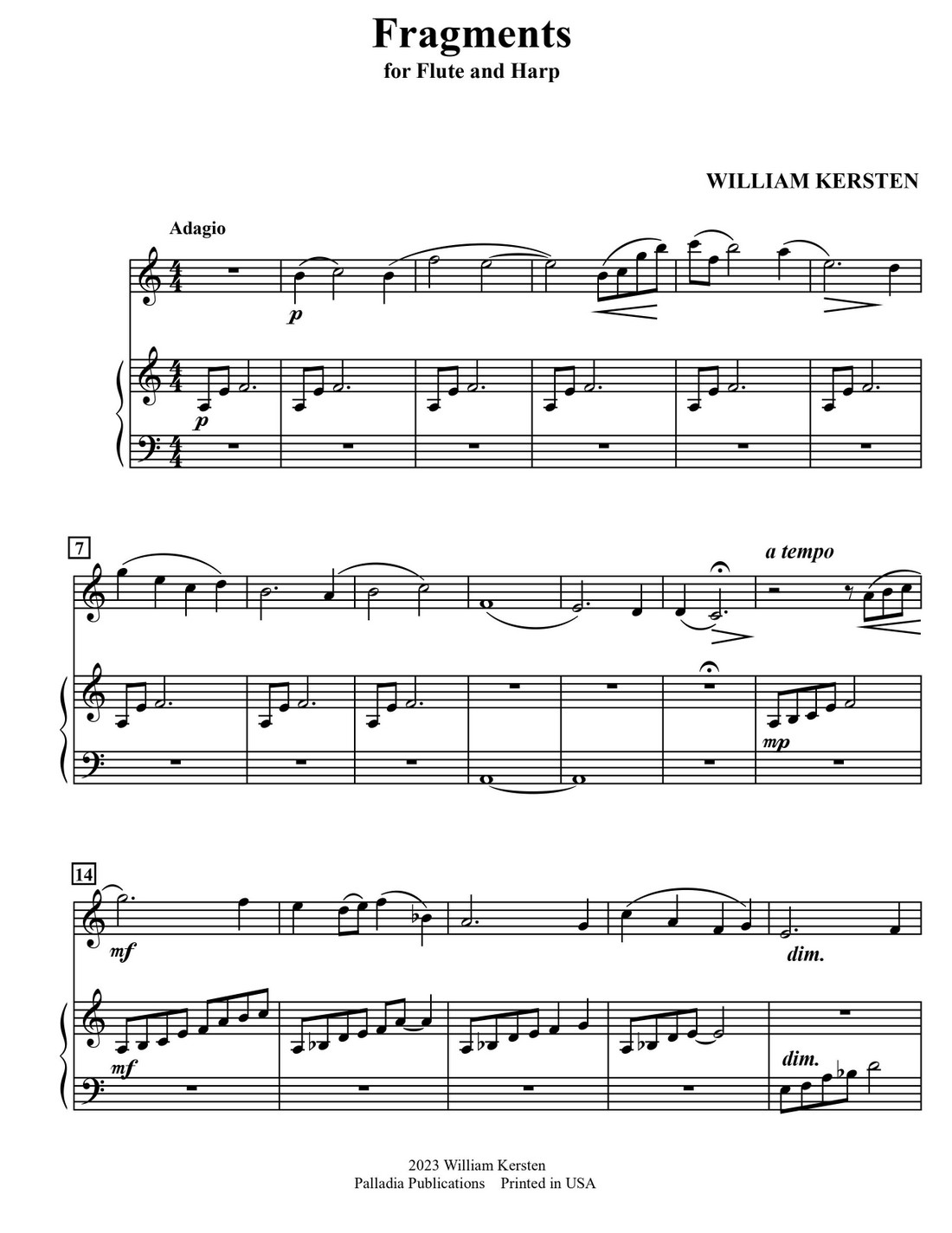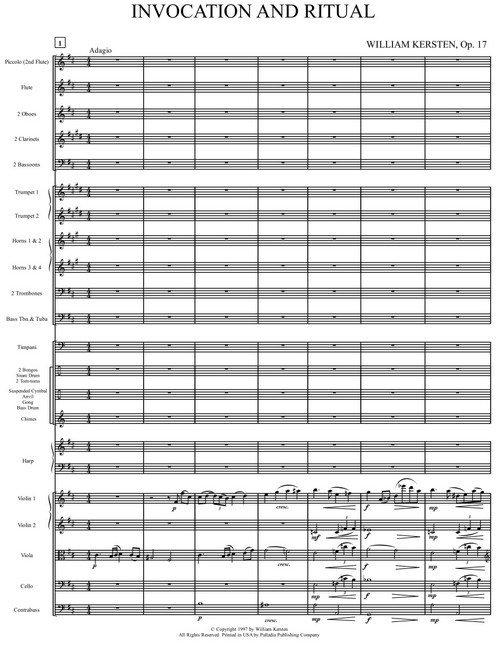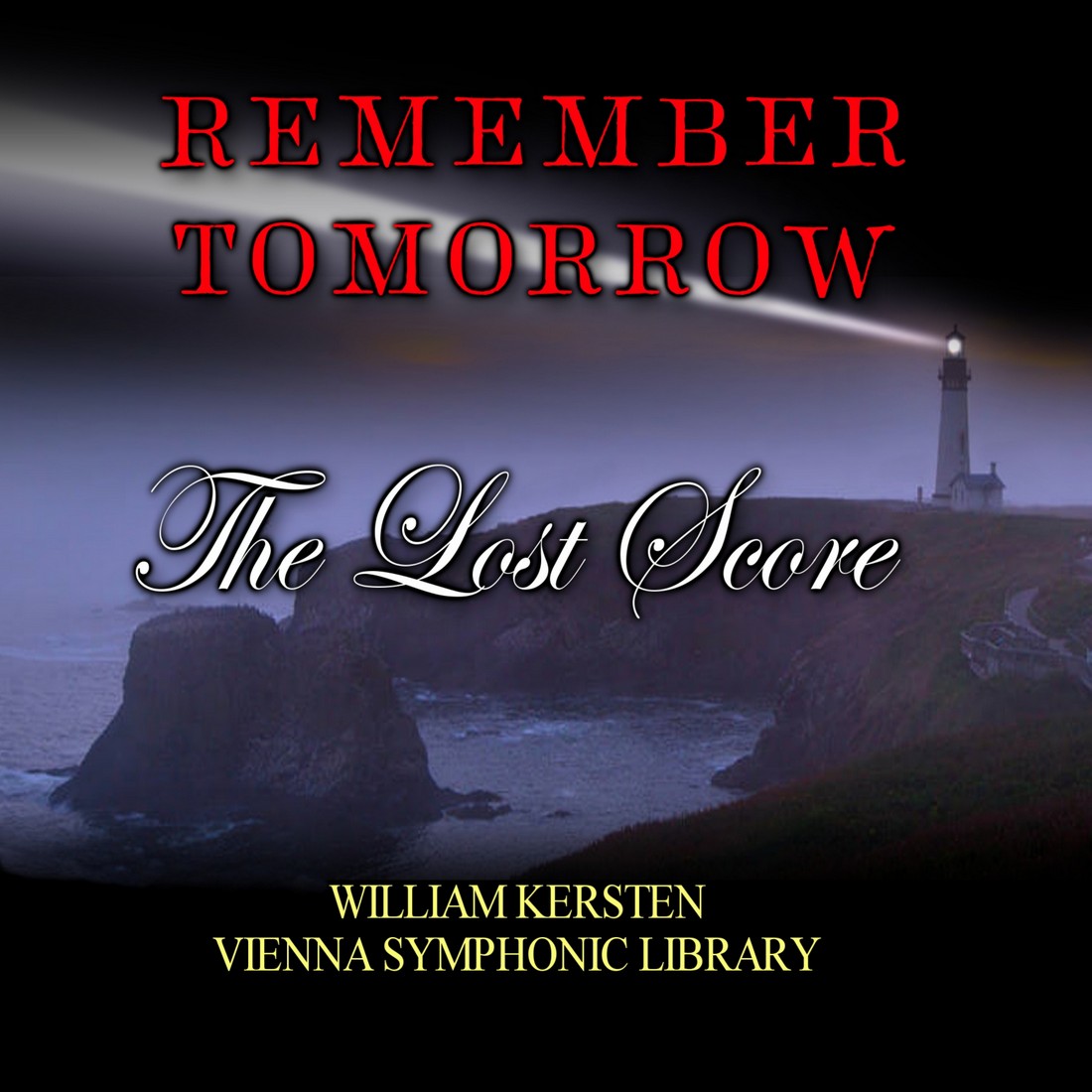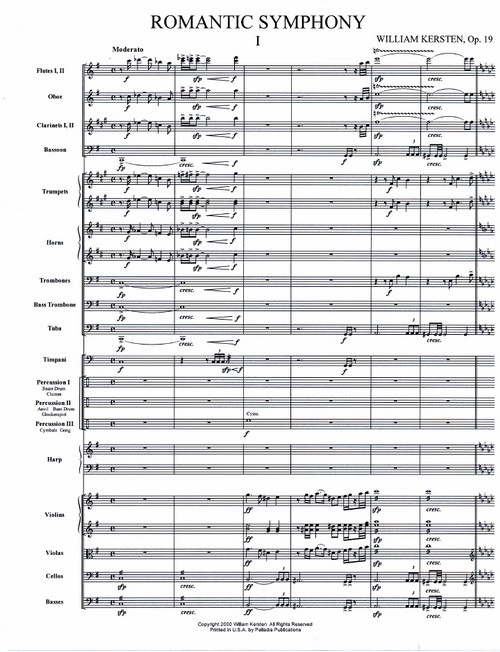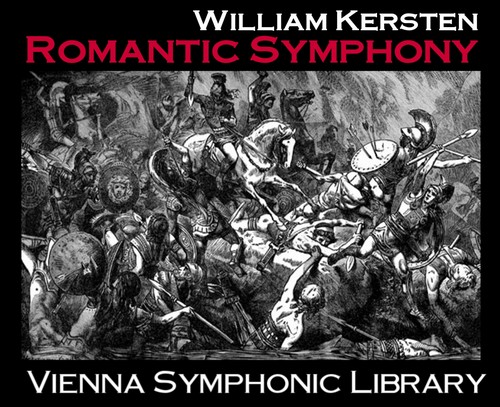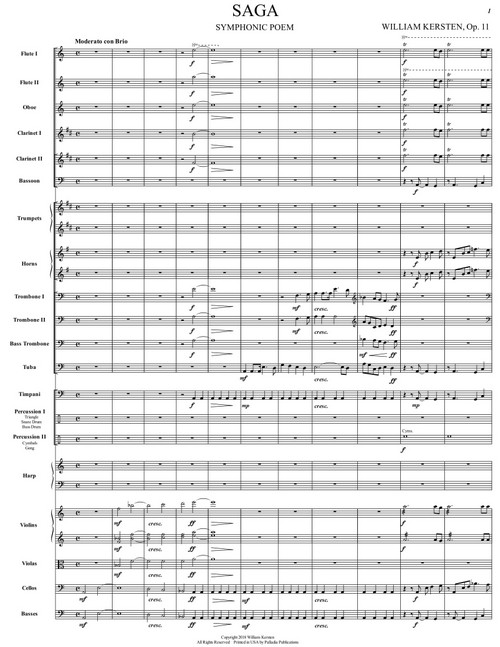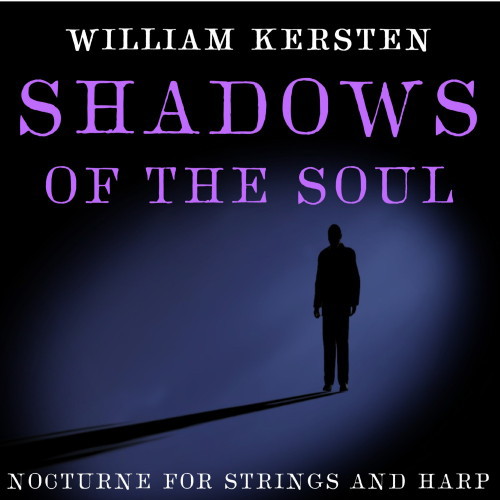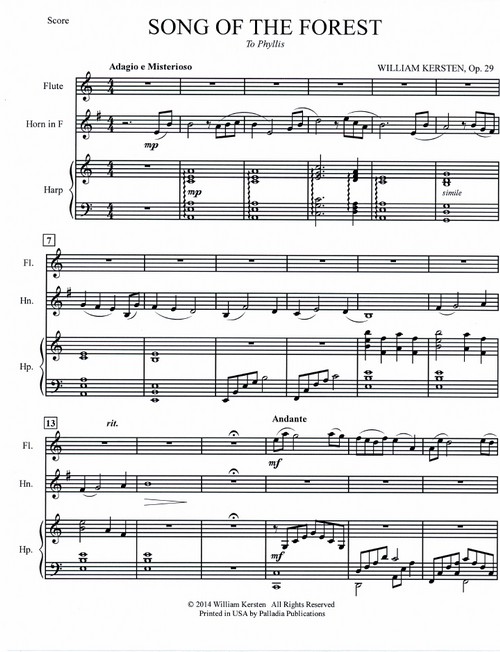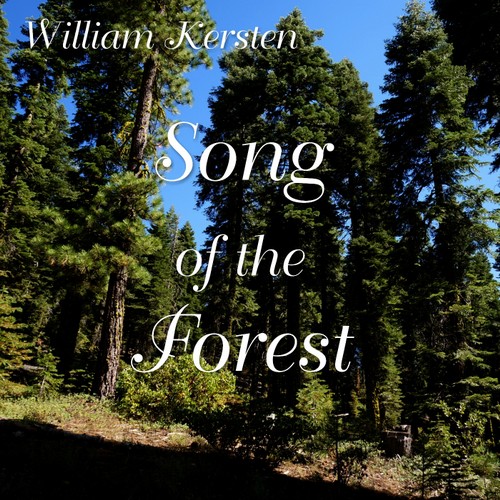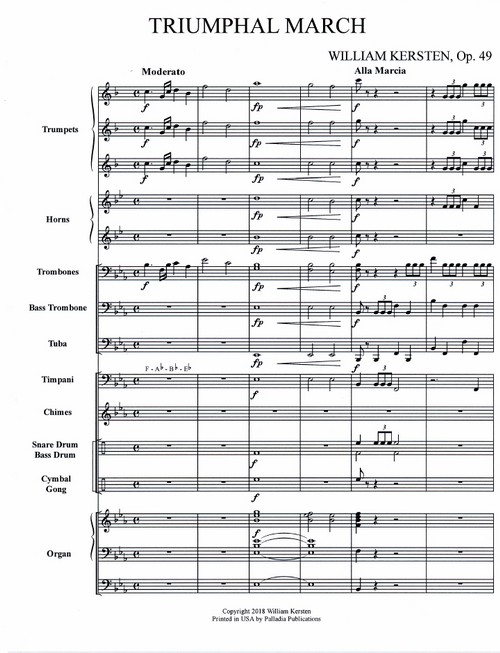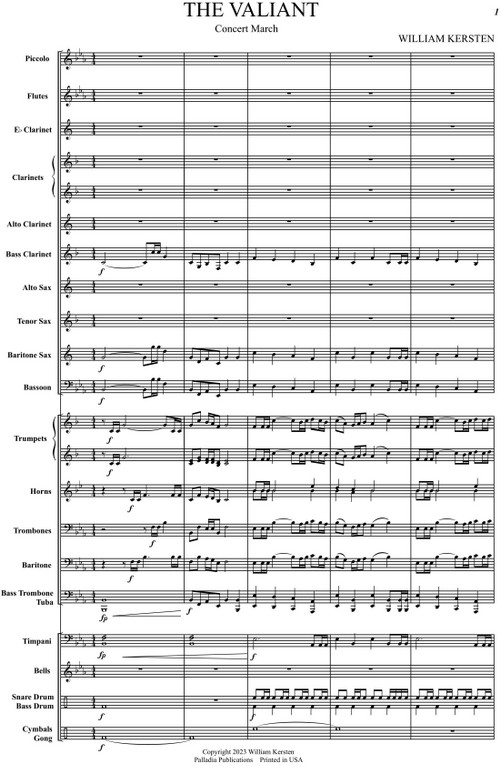"Age of Light" - Symphonic Poem, Op. 35 (2011)
"The Symphonic Poem, "The Age of Light," is a triumphal tribute to Enlightenment. This composition shows Kersten's capacity for diversity: his "Concert March" captures the youthful vigor of a marshal parade; "The Age of Light" is a mature, respectful composition. It features elegant melodies, picked up with the clarity of a trumpet and then echoed by other instruments. While darkness will always challenge intellect - and this tone poem gives voice to that conflict - ignorance submits and is vanquished in this anthem for a new Age of Enlightenment, an "Age of Light." This is an inspiring homage to the power of the mind and its ability to conquer all with thought."
- Guy de Broglia
Ancient Song, Trio for Flute, Horn and Harp, Op. 56 (2017)
Scored for full symphonic band. First performed by University of Nevada, Reno Symphonic Winds, conducted by Dr. Roscoe Booth, December 7 1978.
"Kersten's "Concert March," summons all the marshal grandeur one might hope to find in a Roman coliseum or better yet, on the parade ground of some mythical place where heroism shines brightly. Kersten's command of the percussion section of the orchestra is in full evidence as themes are pounded home, underpinning stirring melodies and the strains of horns. Here is valor and bravery, untarnished by a world where gallantry and virtue are forgotten ideals.
While "Concert March" may recall for some the inspired soundtrack of some epic film from Hollywood's Golden Age, Kersten's composition is so much more: it is untethered to some specific celluloid image, but rather it stands on its own, calling on the listener to imagine something far greater than can be captured on film. "
- James Chenowith
Fanfare for Brass and Percussion, Op. 1 (1972)

Five Songs for Soprano, Op. 14
1 A Birthday
2 Echo
3 "There is dew..."
4 "We do lie beneath the Grass
5 "My soul is awakened..."
Individual Songs with Piano Accompaniment:
Text of the Poems:
1. A Birthday
Christina Rossetti (1830-1894)
Lori Trustman, Soprano
My heart is like a singing bird
Whose nest is in a watered shoot;
My heart is like an apple-tree
Whose boughs are bent with thick-set fruit;
My heart is like a rainbow shell
That paddles in a halcyon sea;
My heart is gladder than all these
Because my love is come to me.
Raise me a dais of silk and down;
Hang it with vair and purple dyes;
Carve it in doves and pomegranates,
And peacocks with a hundred eyes;
Work it in gold and silver grapes,
In leaves and silver fleurs-de-lys;
Because the birthday of my life
Is come, my love is come to me.
2. Echo
Christina Rossetti
Lori Trustman, Soprano
Come to me in the silence of the night;
Come in the speaking silence of a dream;
Come with soft rounded cheeks and eyes as bright
As sunlight on a stream;
Come back in tears,
Oh memory, hope, love of finished years.
Oh dream how sweet, too sweet, too bitter sweet,
Whose wakening should have been in Paradise,
Where souls brimfull of love abide and meet;
Where thirsting longing eyes
Watch the slow door
That opening, letting in, lets out no more.
Yet come to me in dreams, that I may live
My very life again though cold in death -
Come back to me in dreams, that I may give
Pulse for pulse, breath for breath:
Speak low, lean low,
As long ago, my love, how long ago.
3. "There is dew...”
Thomas Hood (1799-1845)
There is dew for the flowret
And honey for the bee,
And bowers for the wild bird,
And love for you and me.
There are tears for the many
And pleasures for the few;
But let the world pass on, dear,
There's love for me and you.
4. "We do lie beneath the grass...”
Thomas Beddoes (1803-1849)
We do lie beneath the grass
In the moonlight, in the shade
Of the yew-tree.
They that pass Hear us not.
We are afraid
They would envy our delight, in our graves by glow-worm night.
Come follow us, and smile as we;
We sail to the rock in the ancient waves,
Where the snow falls by thousands into the sea,
And the drowned and the shipwrecked have happy graves.
5. "My soul is awakened...”
Anne Bronte (1820-1849)
My soul is awakened, my spirit is soaring
And carried aloft on the wings of the breeze,
For above and around me the wild wind is roaring
Arousing to rapture the earth and the seas.
The long withered grass in the sunshine is glancing,
The bare trees are tossing their branches on high,
The dead leaves beneath them are merrily dancing
The white clouds are scudding across the blue sky.
I wish I could see how the ocean is lashing
The foam of its billows to whirlwinds of spray,
I wish I could see how its proud waves are dashing,
And hear the wild roar of their thunder today.
Invocation and Ritual, Op. 17
First performed by Nevada Festival Ballet Orchestra, conducted by Dr. David Ehrke, March 1, 1997
Prospice for Tenor, Op. 24 (2007)
Prospice is based on the poem by Robert Browning, written after the death of his wife Elizabeth Barrett Browning. Browning's metrically complex verse forms a powerful and heroic statement of defiance in the face of death.
Text of the Poem:
Prospice
Robert Browning
Fear death? - to feel the fog in my throat,
The mist in my face,
When the snows begin, and the blasts denote
I am nearing the place,
The power of the night, the press of the storm,
The post of the foe;
Where he stands, the Arch Fear in a visible form
Yet the strong man must go;
For the journey is done and the summit attained,
And the barriers fall,
Though a battle's to fight ere the guerdon be gained,
The reward of it all.
I was ever a fighter, so - one fight more,
The best and the last!
I would hate that death bandaged my eyes, and forbore,
And bade me creep past.
No! let me taste the whole of it, fare like my peers,
The heroes of old,
Bear the brunt, in a minute pay glad life's arrears
Of pain, darkness and cold.
For sudden the worst turns the best to the brave,
The black minute's at end,
And the elements' rage, the fiend-voices that rave,
Shall dwindle, shall blend,
Shall change, shall become first a peace out of pain,
Then a light, then thy breast,
Oh thou soul of my soul! I shall clasp thee again,
And with God be the rest!
Remember Tomorrow, Op. 18, Motion Picture Score (1988)
Composed for the unreleased film, the score features solo piano with full orchestra in a Romantic, concerto-like style.
Symphony No. 1 "Romantic," Op. 19 (1996)
Moderato
Adagio Dolore
Scherzo
Finale
The symphony was written over a period of five years, and uses a melodic and harmonic style inspired by the early Modern and late Romantic composers such as Holst and Mahler though with a deliberately simpler approach to symphonic form and development. In addition to the large string ensemble, it has full brass and winds augmented with a large percussion group and a majestic pipe organ solo in the climax of the finale.
"...I'm floored. Great music, performed masterfully."
- Dietz Tinhof, Audio Engineering Supervisor, Vienna Symphonic Library
"In the Romantic Symphony (Symphony No. 1 Op. 17) Kersten has provided no obvious program. Still it moves where the spirit moves him as though following the action of a drama, not where strict attention to musical form once demanded, but to where heart's desires and instincts demand. Kersten knows what many of his contemporary composers don't evidently know, or at least don't care to express: that contemporary music can reflect its time and still be accessible to listeners who want to be thrilled by modern sounds adorned with lovely melodies, without being pummelled by extraordinarily gritty dissonance.
The symphony has power and drama. It also has rapture and radiance. Bright-hued with touches of foreboding throughout, every theme singing smoothly, every development integrated and effortless, the work defies neat classificiation other than to say that at its most profound (the first movement) it's theatrical and exciting, at its most lyric (the second movment) it's poignant and richly textured, at its most exotic (the third movment) it's exhilirating and enticing, and at its most noble (the fourth movement) it's powerful and spirited and engulfs the listener with a unabashed adrenalin rush as it forges ahead to its triumphant conclusion.
From its misty Mahlerian beginnings to its final burst of Wagnerian splendor, Kersten's Romantic Symphony captures a restless urge that propels this expressive and richly varied work in an inspired and engaging way."
- Jack Neal, 2003
"Cries of righteous despair replete with filmic imagery bring about a highly portentous, resolute theme containing fragments of narrative commitment, which is in turn interrupted by penetrating, inescapable anguish that the composer must brave and tame in order to dive into the first movement - and the symphony - proper, where we have a chance to explore the musical and psychological implications of those fierce introductory eruptions. All this happens during the first ninety seconds of the work.
The listener embarks upon a personal musical disclosure of events, while receiving the full range and impact of the emotional content of those events, not necessarily in a linear or traditional formal fashion - for which the title of ‘Symphony’ may be misleading unless one’s conceptions and traditional expectations are left behind on this very personal journey. The apparent absence of traditional formal cornerstones doesn’t weaken the larger structure, as the skeletal interweaving of themes and an abundance of dramaturgy and personal dictum, shift the educated audience’s conventional expectations of balance in a large work to the composer’s discretionary points of structural centres, as motivic/harmonic growth, orchestration, style, and even long-range musical targets, all defer to the composer’s own hierarchical system in this work, and serve his narrative and psychological struggles - perhaps ‘Symphonie Fantastique’ or ‘Sinfonia Narrativa’ could be alternative titles. In fact, the narrative intent is so much stronger than the rich musical material, that the movements could easily be perceived as sections of an instead monolithic musical epic, seen through the eyes and expressed in the singular voice of an individual witness.
We never become privy to the composer’s story without the intentionally undisclosed literal programme, and that draws us deeper into the work in search of that fascinating story - the very emphatic musical material suggests strong feelings of loss, despair, love, battle, religion, and triumph.
Technically, the composer feels secure in his uninhibited use of some Herrmannian, Tchaikovskyan, and Beethovenian devices, and a degree of stylistic eclecticism from different periods, as his own strong and original voice is ubiquitous and assimilating.
As one becomes more familiar with this and other works of W. Kersten, one is incrementally allowed greater insight into his mysterious and expansive world - a natural outcome over repeated hearings (a surprisingly welcome venture in the contemporary music world). And it is these repeated hearings that tell us that the work is worthwhile, when we discover something new about it every time; new layers, new elements, or new connections between those elements, etc.
W. Kersten’s music is as generous in these respects, as it is inspired. Most of all, it is honest; an almost extinct quality these days, especially in music composition."
- Errikos Vaios, Greece, 2013
Shadows of the Soul, Nocturne for Strings and Harp. Op. 33
Shadows of the Soul - Nocturnes for Orchestra (2010)
1 Late Afternoon, Op. 25
2 Come Darkness, Op. 26
3 Dolore, Op. 27
4 Night Walk, Op. 28
5 Fragments, Op. 29
6 The Haunted Mind, Op. 30
7 Foreshadows, Op. 31
8 Elegy, Op. 32
9 Shadows of the Soul, Op. 33
"Shadows of the Soul" is a rich, diverse album, a collection of brilliant melodies executed with precision to yield a mystic, sometimes disturbing poem. As is typically the case with Kersten's music, these various compositions recall images, as though from some forgotten past, fleeting and conjured out of the private imagination, which only that listener can know. And yet, while "Shadows of the Soul" summons phantasms at once individually conceived, it also draws on archetypes as though Carl Gustav Jung himself directed the orchestra. Here is the eerie Neo-Romanticism of a new turn of the century at its best. Kersten always delights, and "Shadows of the Soul," complex and evocative, is no exception. "
- Guy de Broglia
Song of the Forest, Trio for Flute, Horn and Harp, Op. 50 (2013)
"The "Song of the Forest," explores the sylvan delights of the woods. Just as a walk along some seldom-trod path leads one to the unexpected - a brook, a stone outcropping, or the hoary, moss-encrusted face of an aged tree - so too does Kersten's composition offer repeated enchantments, unexpected but encountered, nevertheless, with each turn of phrase. The masterful composer who consistently illustrates his versatility has given us the most outstanding of gifts with his "Song of the Forest," a bewitching journey along a leaf-shaded trail."
- James Chenowith
